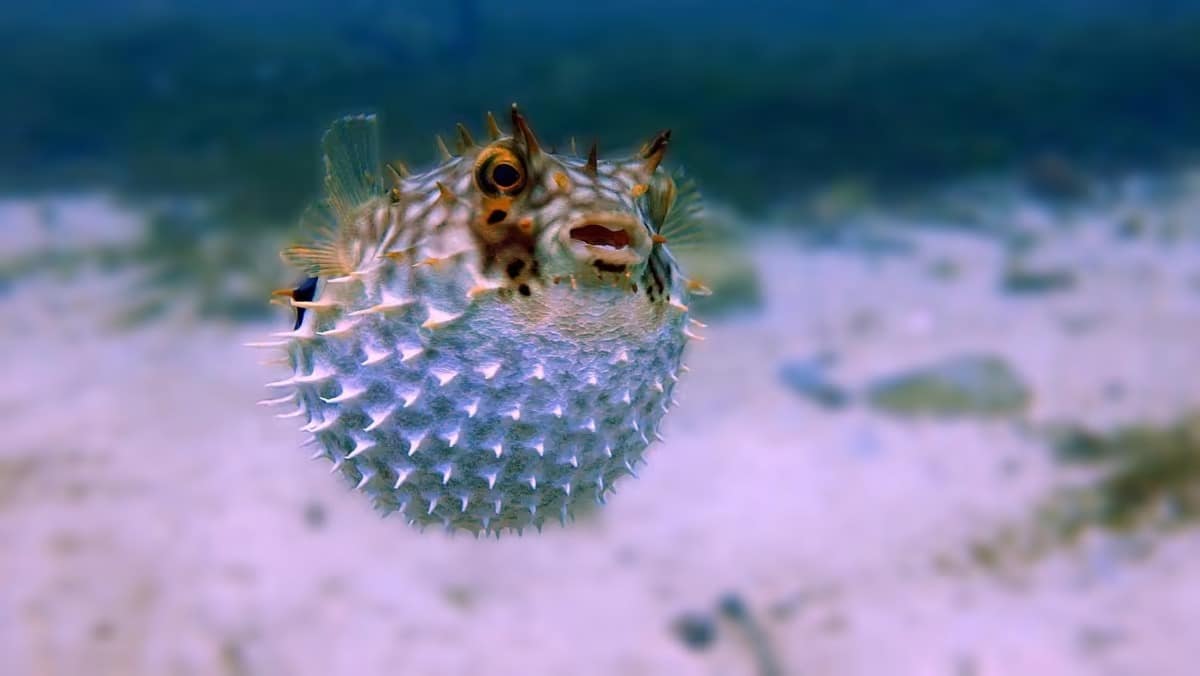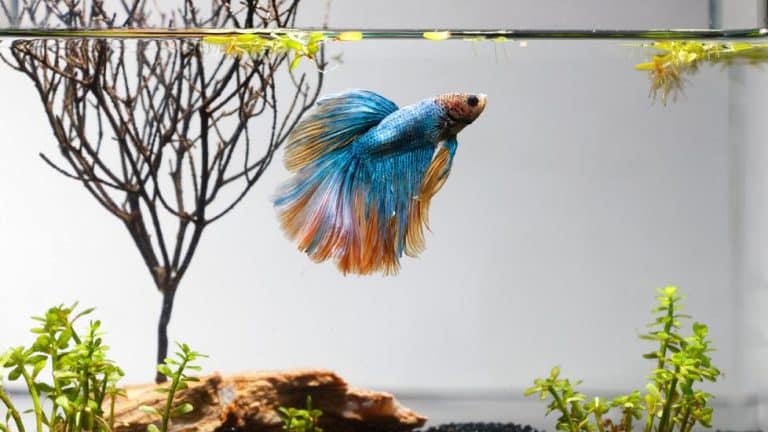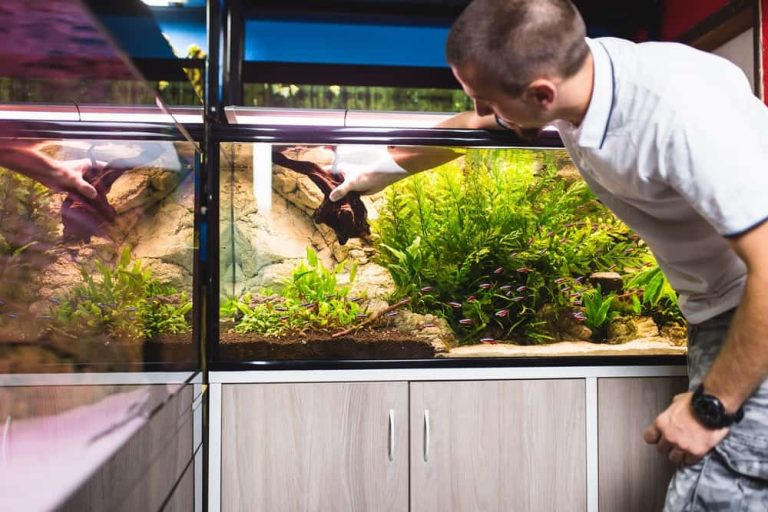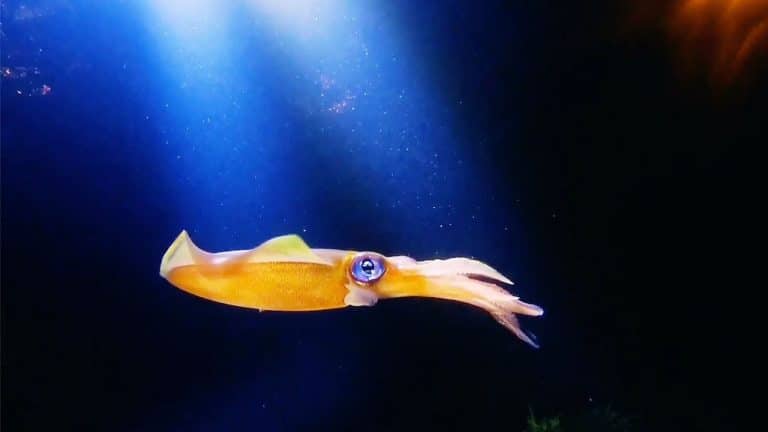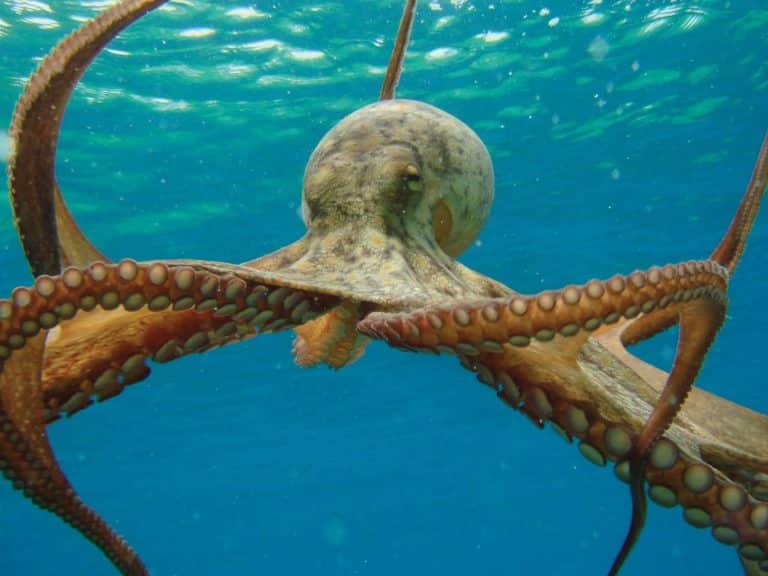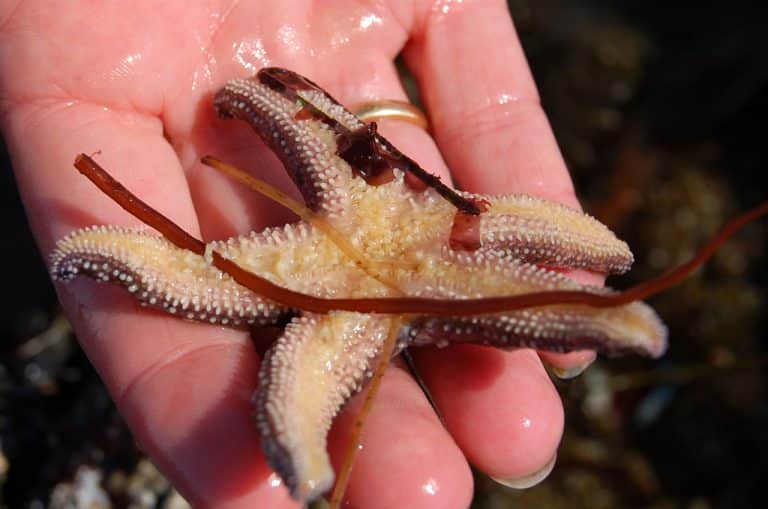Guide to Blowfish: Overview, Types, Facts, and Mating
Have you ever wondered about the world of the blowfish or pufferfish? These fish species of the deep are renowned for their appearance and behaviors.
Often known as pufferfish, they possess a unique ability to transform their body into inflated, spiky orbs in an instant.
This is a self-defense mechanism against potential predators that may want to harm them.
But there’s more to blowfish than just their protective puffs or spikes. The patterns and colors make them truly remarkable and uplift the entire scene of the ocean, making them a perfect addition to many aquariums.
In this article, we invite you to dive into the facts of blowfish and how it is a special fish among the others. We will also delve into their behaviors and discover the art of blowfish keeping.
Let’s get started!
Overview of Blowfish
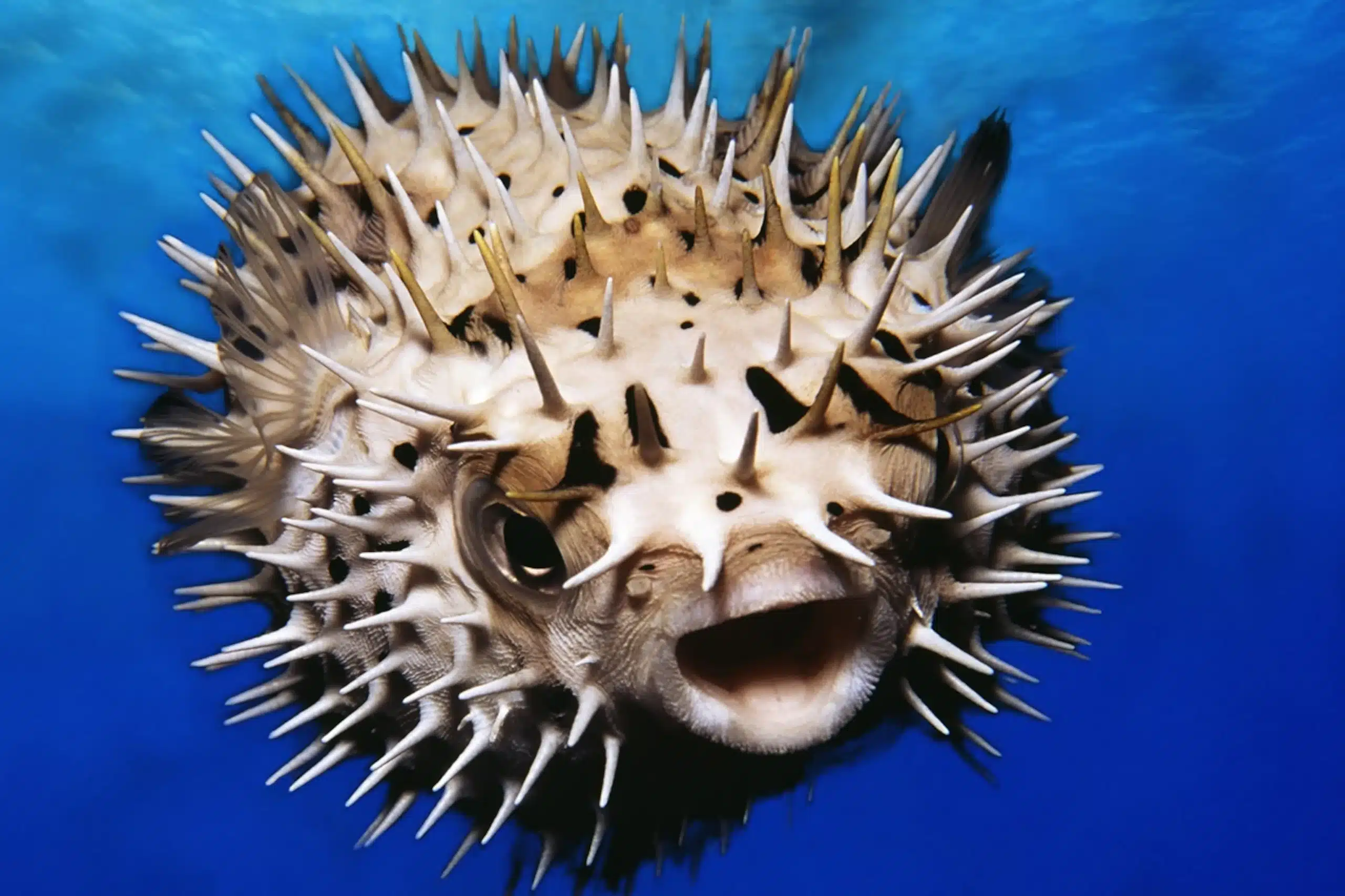
Blowfish or pufferfish are often found in tropical and sub-tropical ocean waters, and the feature that makes them truly unique is their ability to inflate their skin with spikes when they sense there is an imminent danger to their lives.
Those spikes contain toxins that will further protect them.
Blowfish are known to be the second most poisonous vertebrates in the world, coming only after the golden poison frog. Even some of their organs contain toxins, which, if ingested by predators, become life-threatening to the latter.
Currently, more than 120 species of pufferfish are roaming around the ocean’s deep waters and several aquariums. They are highly concentrated in the tropics since they prefer warm waters.
Even though they walk slowly and can become easy targets for predators, their defense mechanisms keep them pretty safe.
Blowfish can also fill up their tummy with water, which makes them turn round, and the spikes get much more defined, protecting them even more.
Puffer or Blowfish are very similar to chameleons found on the land surface. Like the chameleons, Blowfish can also move their eyes independently and camouflage themselves as per the environment and the scene.
Moreover, even after looking so bright and distinctive with their distinct colors and bodies, puffers rarely attempt to hide from imminent predators.
Potential Threats to Blowfish
1. Pollution and Algae
This is one of the biggest blows to the Blowfish population worldwide. With the constant rising temperatures, the algae population is drastically reduced, the major food source for fishes and corals.
Even the polluted waters affect the production of algae in the ocean, which is why it’s required to not throw any plastic or chemical waste in large water bodies.
2. Overfishing
Overfishing means the rate of fishing a particular fish is more than the production of that fish. Blowfish is widely overfished due to its usage in many delicacies.
What’s interesting to know is that this fish’s toxins are 1200 times more poisonous to humans than even Cyanide. Yet, it is widely regarded as a delicacy in many cuisines due to its taste, tenderness, and soft bite.
3. Pet Trade and Animal
Blowfish are victims of the illegal pet trade and of the entertainment industry. As we already discussed, Blowfish are a huge attraction for aquariums as they are seen as ornamentals.
These fishes are removed from their natural habitat without any second thought and cannot engage in their natural behaviors.
Captivity itself is cruel for a fish. Mental illness and a weakened immune system due to lack of physical activity harm the fish.
Different Types of Blow Fish
1. Congo Pufferfish
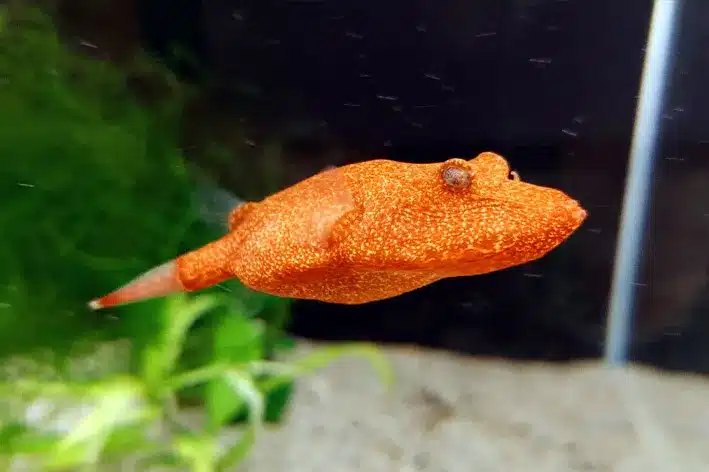
This fish is native to Africa, and the name comes from the Congo River. This fish, also known as a Potato Puffer, can grow to around 15 centimeters.
These species tend to be spotted, and their population is generally considered healthy.
If you want to have a Congo Pufferfish in your aquarium, you need to have a lot of space, i.e., at least 20 gallons per fish, which is a lot.
2. MBU Pufferfish
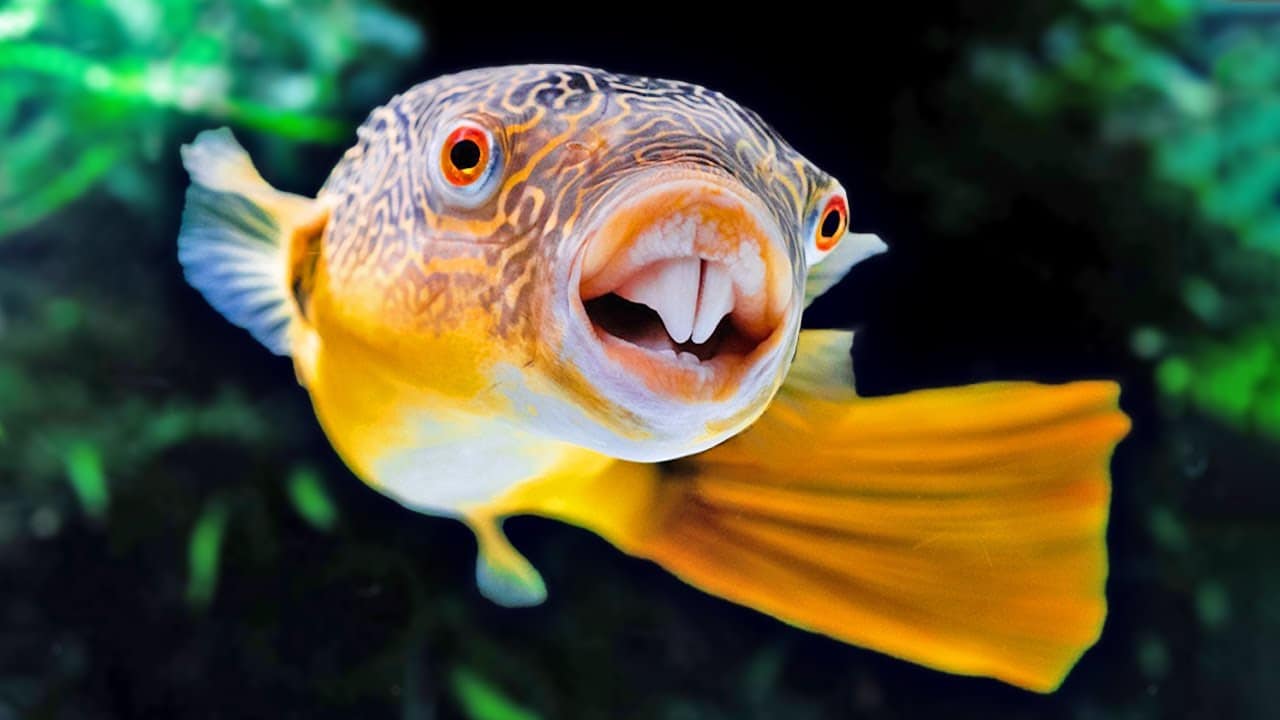
MBU Pufferfish are also sometimes known as Giant pufferfish, thanks to their size. They can grow up to 26 inches long and require 125 gallons of water to live in a conducive and preferred environment.
This huge amount of water cannot fit into any normal-sized aquarium; hence, these are not very popular or commercially traded.
Their food requirements are also unique; they need hard-shelled foods to contain their tooth growth.
3. Red-Eyed Pufferfish
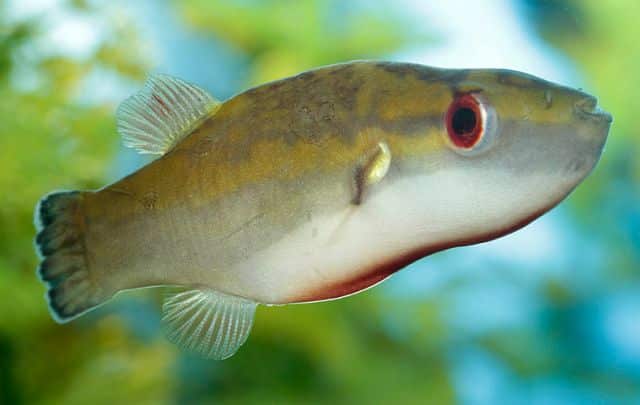
Red Eyed Pupperfish has quite a unique appearance as compared to other puffers. Their outer skin is usually in a combination of black and different shades of silver, and their eyes are red, making them look truly exquisite.
This look intimidates some people, while others enjoy how they look. These fish can be kept in the aquarium as not only do they require less water, but also they only grow up to 7 centimeters.
4. Dwarf Pea Pufferfish
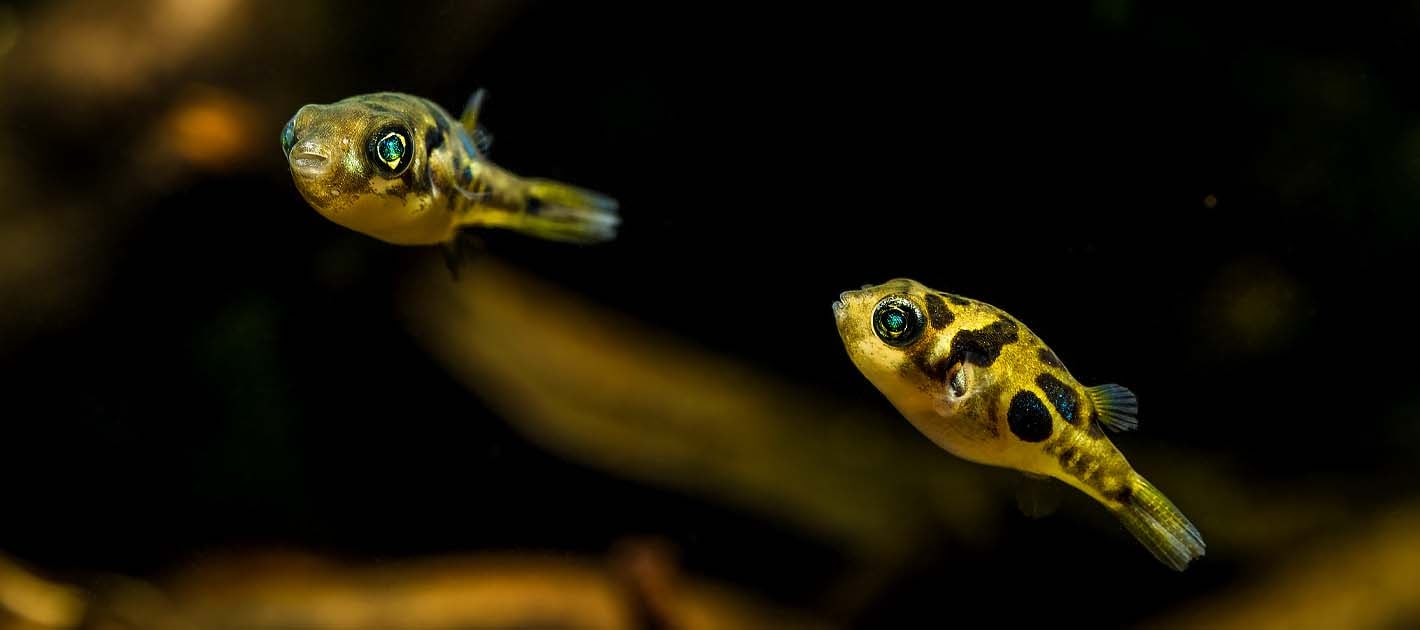
As the name suggests, Dwarf Pea Puffers are very small, spanning only 3.5 centimeters, making them a perfect attraction for aquariums. They originated in India and come in yellow with black spots.
These puffer fish prefer to eat frozen bloodworms, brine shrimp, and pest snails. But remember that they are quite aggressive and can destroy other fish species in your aquarium.
5. Fahaka Pufferfish
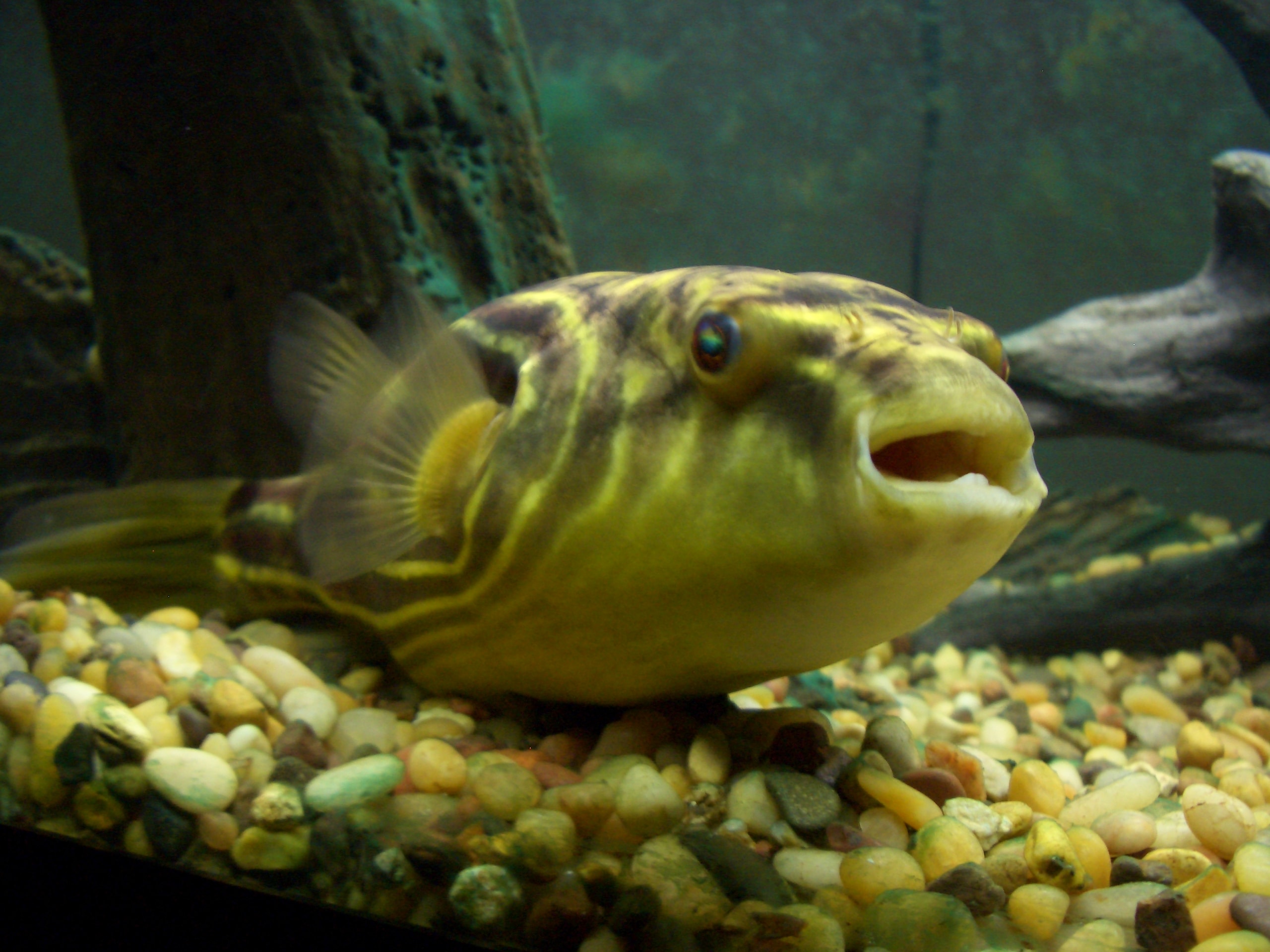
This species of Blowfish also originates in Africa, and they have patterned or striped bodies. This fish can grow quite large, i.e., 43 centimeters, so it cannot easily fit into most aquariums available in the household.
Due to the sheer size of this fish, the water requirement to keep the fish in close enclosure is also quite high, ranging up to 120 gallons of water from the minimum 55 gallons per fish.
We suggest that if you are a beginner in keeping aquariums, this fish should not be your choice as they are very aggressive and ears crabs and crayfish.
6. Amazon Puffer
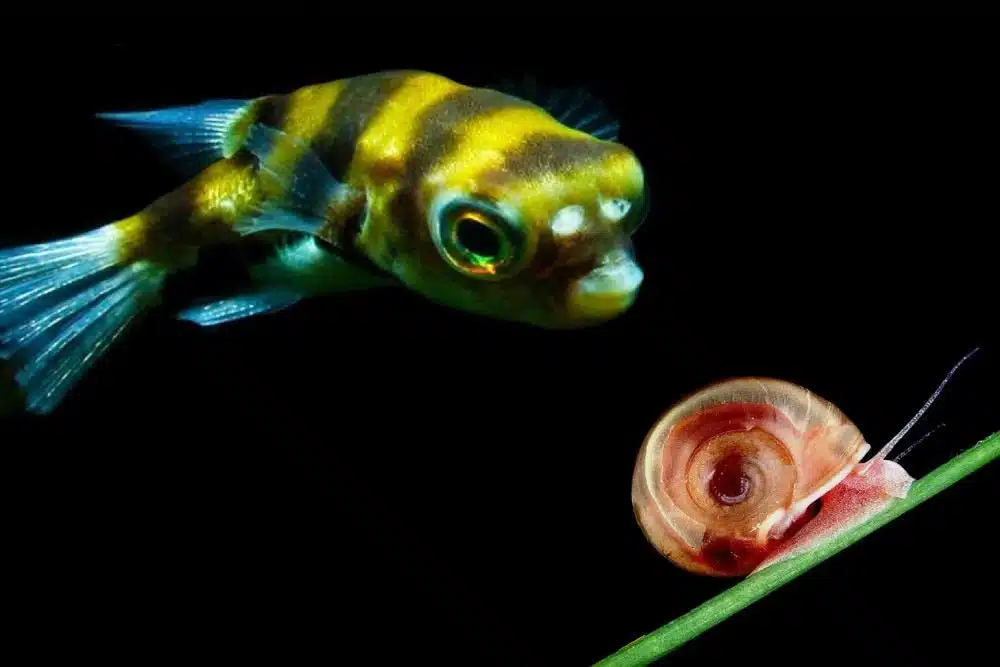
You can guess that this fish originates in the Amazon River. It has a yellow belly, and the whole body is covered in black and yellow strips, giving it a very glowy appearance.
This fish is typically small and can only grow up to 10 centimeters.
This species of Blowfish is extremely active and swift in waters, and because of this, they are comfortable in larger fish tanks.
To maintain their teeth, they require hard-shelled food even though they can also eat plant-based food.
7. Figure Eight Pufferfish
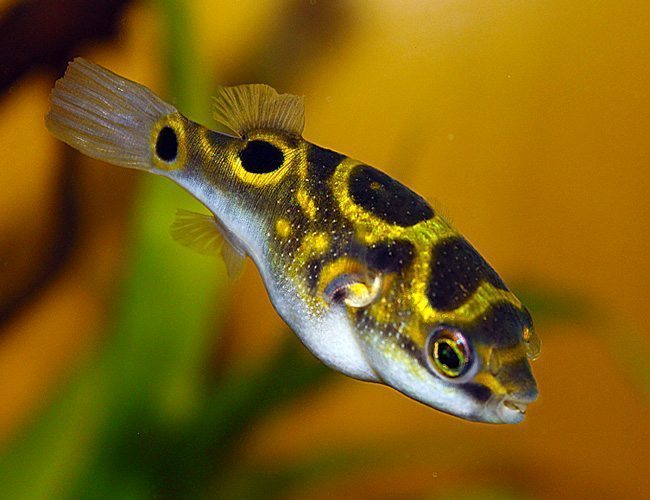
This species of Blowfish has markings on the body, which closely resemble the marking eight, and that’s how it got its name.
This is a smaller species of pufferfish, and it rarely gets bigger than 3 inches, even when fully grown.
Their teeth can also suffer adversely if they don’t get the hard-shelled food. Just remember that these types of Blowfish are super aggressive, which makes them hard to contain in a community tank setup.
8. Imitator Dwarf Puffer
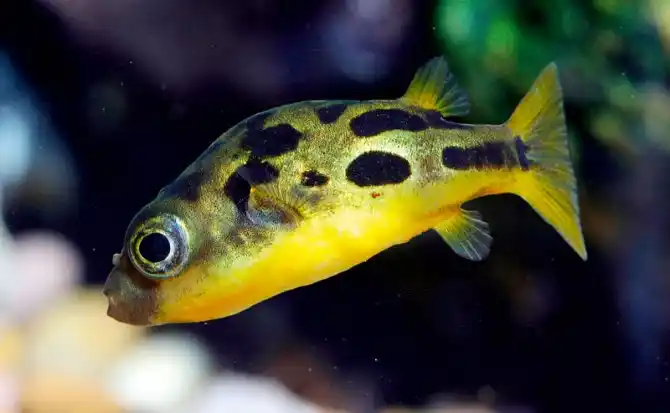
This species of the Blowfish is very similar to the dwarf peas. The only difference is Imitator Dwart Puffer has fewer spots.
As they are in the dwarf category, they only grow up to 4.5 centimeters, making them one of the smallest Blow fish species.
There is good news: you can easily keep them in an aquarium since they only require 3 gallons of water per fish.
9. Green Blowfish
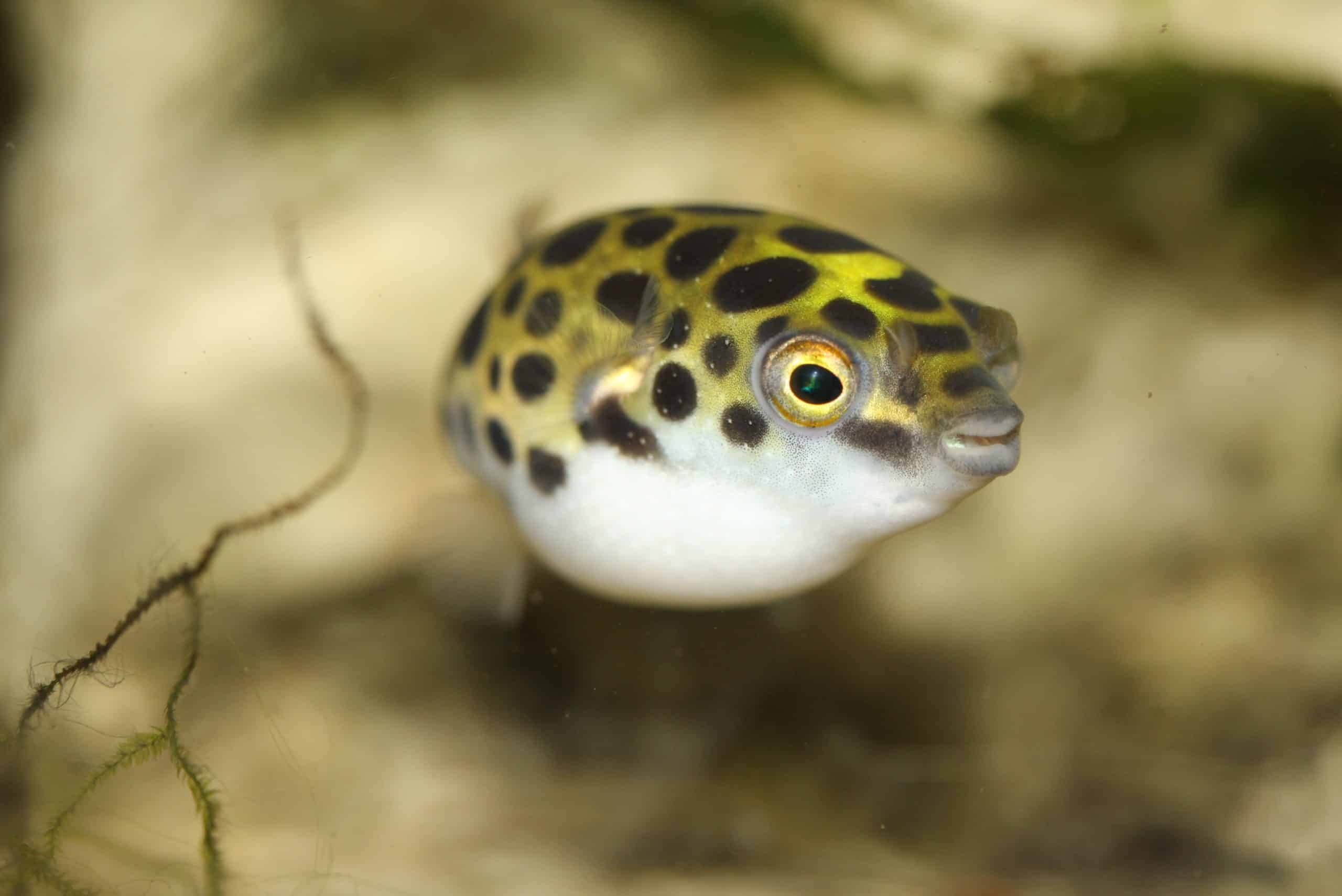
Green pufferfish are most commonly located in rivers, lakes, and some parts of floodplains in Southeast Asia. They have beaks other than the teeth, which can be maintained by feeding them hard-shelled foods.
This blowfish species can grow up to 7 inches, and like most species of Blowfish, this can also get quite aggressive and cause a chaotic situation in a community tank.
Remember that they are carnivorous and would not like to eat plant-based foods.
10. Blue-Spotted Pufferfish
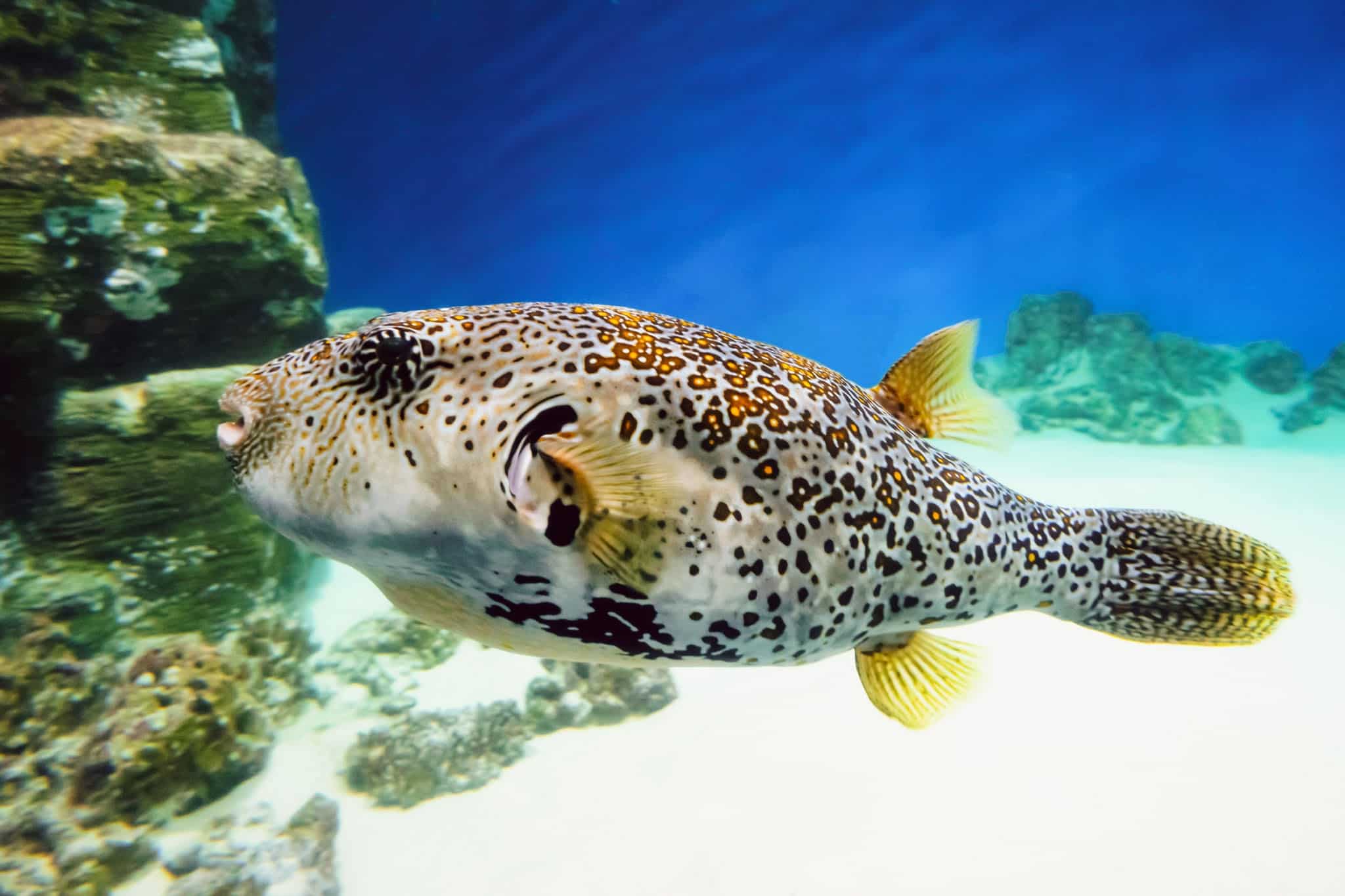
This type of Blowfish special thrives in saltwater environments as well. They look extremely peculiar, with a sun-like pattern near their eyes, giving them a depth effect.
They can grow up to 13 centimeters and are natively found in the Indian and Pacific Oceans. Their body is covered with multiple colors, making them eye-catching for your aquarium.
11. Golden Pufferfish
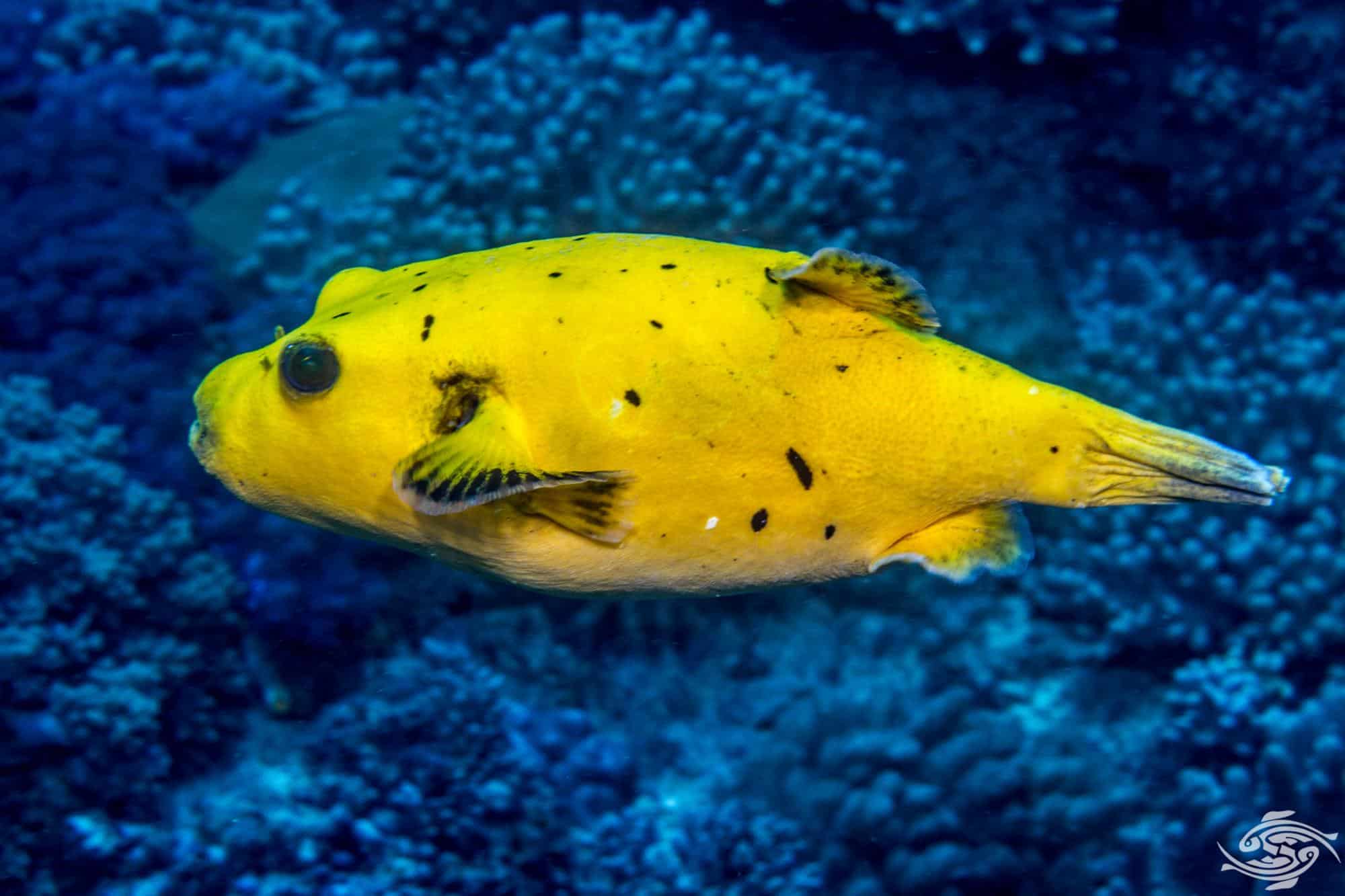
This species of Blowfish is also known as Guineafowl Puffer because these fishes look bright yellow with black spots.
They are natively located in the Pacific, where the waters are generally salty and warm. They can reach around 12 centimeters and be a perfect addition to your aquarium.
12. Valentin’s Sharpnose Blowfish
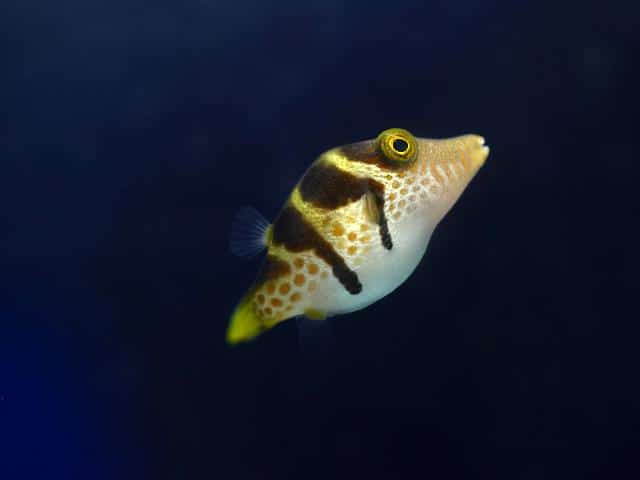
This species of Blowfish justifies its name completely with its long, pointed nose and intricately ornated beautiful patterns. Their whole body is covered in black stripes with small yellow dots.
This Blowfish is native to the Indian and Pacific Oceans.
As we already know, Pufferfish are inherently toxic, and this species of Blowfish is very potent with its neurotoxins.
It’s interesting to know that other fish also started to mimic the appearance of this fish to avoid getting killed.
13. Northern Pufferfish
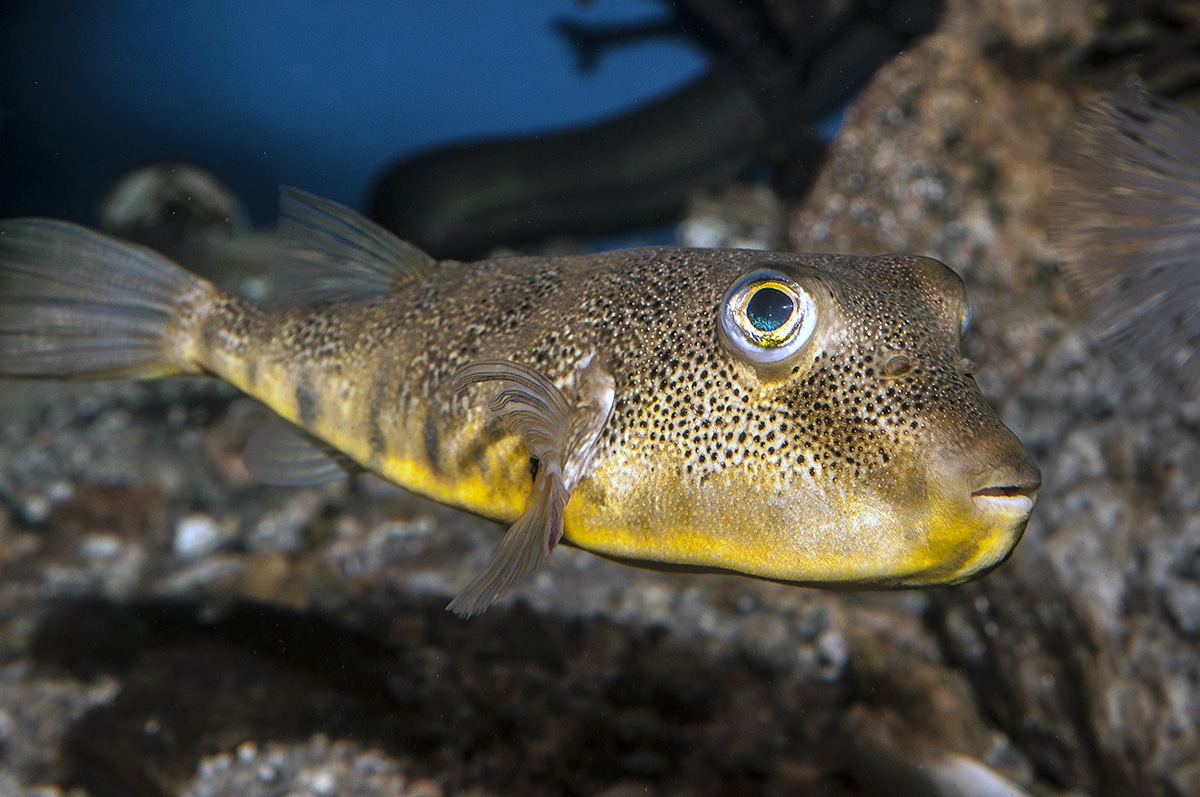
This species of Blowfish is native to the Atlantic Coast. They are also known as ‘Sugar Toads’ near the Capital Region of the United States.
This range is widely established from Florida to Newfoundland; its ranges are abundant.
Their bodies are extremely streamlined, making them a very swift swimmer and also helping them look aesthetic.
14. Blackspotted Pufferfish
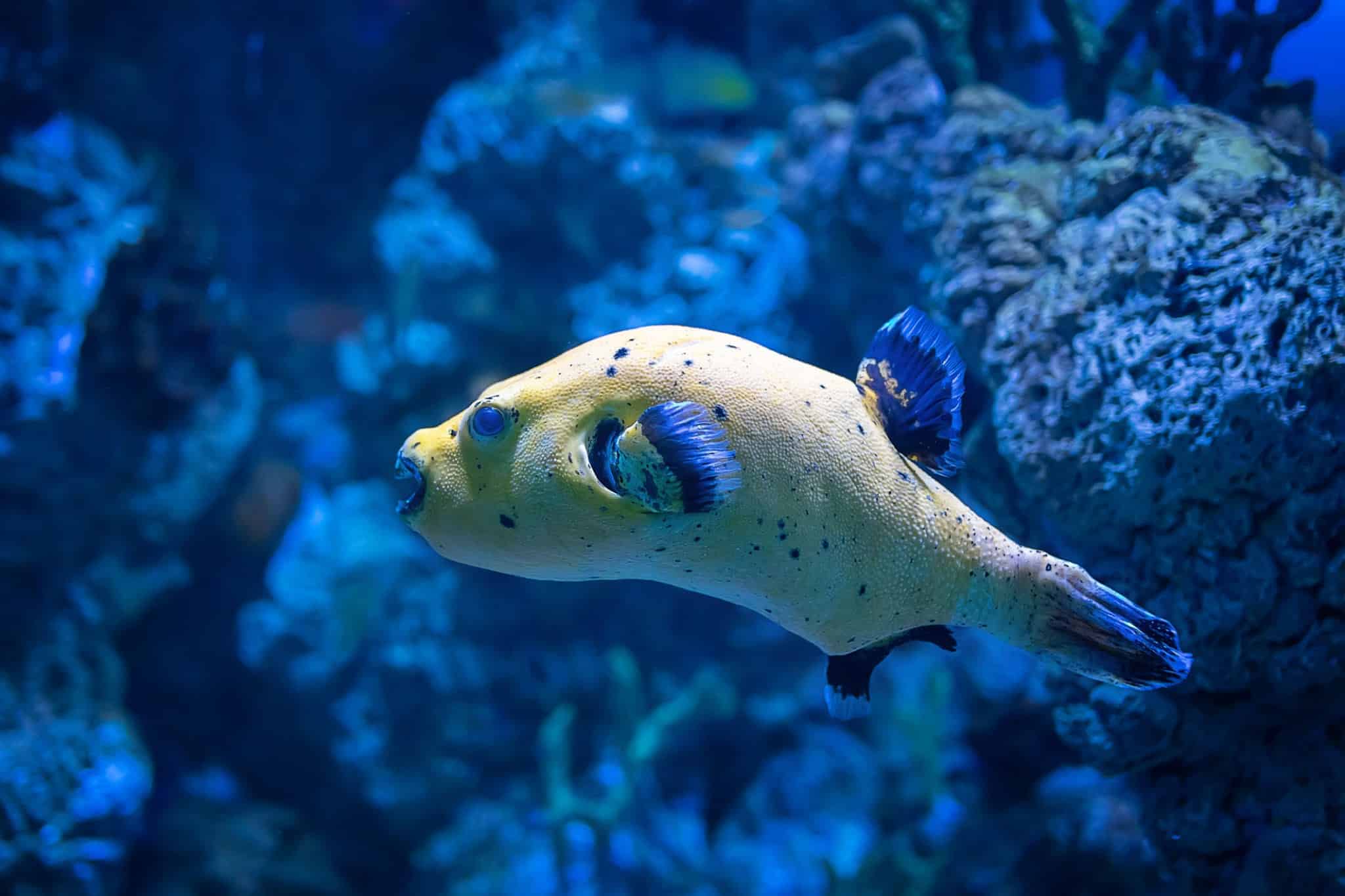
They are also known as dog-faced puffers because of their cute and irreversible seal-like appearance! The dark spots near the mouth closely resemble the puppy snout.
They can grow up to 33 centimeters and get round when grown into adults.
15. Porcupine Pufferfish
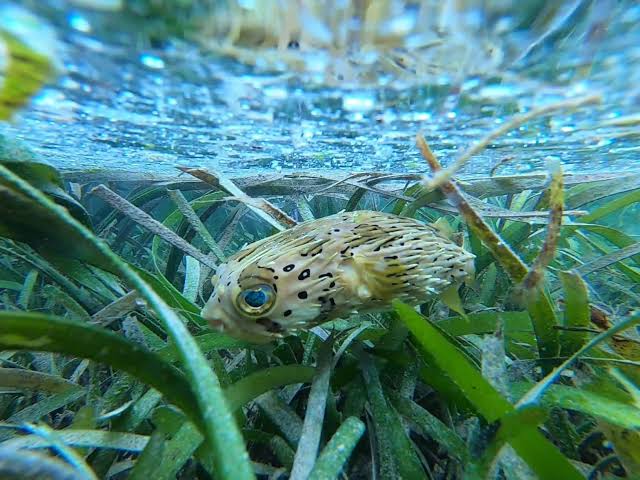
Porcupinefish or Blowfish are generally not considered from the same family of Pufferfishes. However, they are similar in that they can also inflate the spikes on their bodies to protect them from predation risk.
Similarly, they also have highly lethal poisonous tetrodotoxin to protect themselves.
Interesting Facts About Blowfish
- Foul Testing and Deadly: Most blowfish are lethal for humans as they release deadly neurotoxins that make their taste very foul and can be deadly for their predators as well.
- Turning into a Ball: Blowfish often turn into round balls by drinking and expanding their size several times more than normal to discourage predators from attacking them.
- Spikes: The Blowfish have enough spikes to ward off the predators. Even if consumed, they are not enjoyable because of the spikes. And don’t forget the harmful toxins. It is said that one Blowfish can kill 30 adult humans.
- Prepared By Trained Chefs: This fish is enjoyed greatly in Japan, Korea, and China, but here is the catch! Not everyone can make it, and there are trained chefs called ‘fugu chefs’ who can cook it properly to eliminate harmful toxins. With all the extensive preparation needs, this dish becomes a bit expensive.
- Quick Swimmers: Blowfish are considered slow swimmers but, when attacked, can quickly gather energy and swim very fast, thanks to their survival instinct. They can be fast, but it comes at the cost of being directionally challenged. In other words, they can swim fast but in a very uncontrolled way!
- Eat themselves: In an open ocean, they eat snails, small fish, crustaceans, etc to survive. However, they can even eat their kind for survival when they are put in captivity, like in an aquarium.
- Bigger Tanks: As compared to most other small fishes, Blowfish require a larger than the normal tank to survive because of their extensive water requirements. The tank should be from 30 gallons to 150 gallons, depending on the type of Blowfish.
- Shallow Waters: Blowfish don’t usually roam in deep waters because they prefer warmer waters. And as we go deeper into the ocean, waters get cooler. This is why most Blowfish live in shallow waters and near the equatorial regions of South America, Africa, the Indian Subcontinent, etc.
- Attracting Females: Blowfish has a unique way of attracting females towards them. They create eye-catching art to attract their mates. First, they choose a suitable spot in the sand. Second, they use their swift and flexible bodies to carve various patterns and geometric figures intricately. These patterns mostly resemble very closely to Mandala Paintings in Buddhist tradition.
- Dolphins Get High: Blowfish release toxins to prevent predators from attacking them. However, those toxins help dolphins get high, and they purposely inhale the chemical released by a Blowfish to get high. After inhaling, Dolphins act a little crazy and funky, making them look high.
- Toxin Based on Color: The amount of toxin produced in a Blowfish is directly proportional to the brightness of the fish. If the color of the Blowfish is bright, the Blowfish releases a large amount of toxins compared to the fish with darker colors.
Reproduction and Mating of Blowfish
Blowfish typically mate in subtropical ocean waters. Male Blowfish push females to the water’s surface with the intention of mating with them.
Females lay hundreds of eggs in a single go due to hatching in just 4 days, a very short gestation period.
The process of mating is simple. Males follow the female into a safe place where the latter can release her eggs for the former to fertilize them.
Lately, people have started commercially fertilizing them to create more offspring to increase profits. This is hard because Blowfish rarely breed in captivity.
Final Thoughts
Blowfish are unique kinds of fish with a solid defense mechanism system having spikes, making them one of the rare species of the ocean.
We have enumerated everything you need to know about this fish, so next time you spot it on your holiday adventure or in an aquarium, you will know their whole history and how to protect yourself from them.
They look very attractive, making people think they are playful and non-dangerous. However, you know the truth about the Blowfish or Pufferfish.
Do comment below about what fascinated you the most about this interesting Blowfish.
Frequently Asked Questions
Do Pufferfish Make Good Pets?
For a beginner who just started building an aquarium, they are not a good choice as they require extensive care in their diet, large water requirements, and can often be deadly to other fishes, especially in a closed environment.
Are Pufferfish Poisonous?
Most Blowfish contain a deadly toxin called Tetrodotoxin, which can harm the nervous system of humans. It is known to be 1200 times more lethal than Cyanide, and there is no antidote made to date as well!

